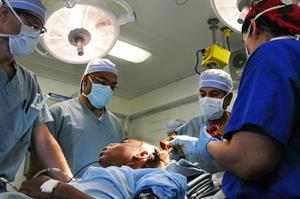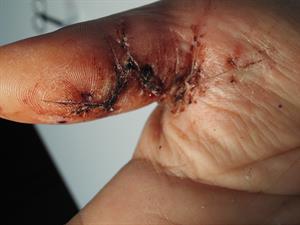PDF chapter test TRY NOW
1. Anaesthetics:
Anaesthetics are drugs that cause a loss of sensation. They are given to patients who are having surgery.
(i). Types of Anaesthetics:
When patients undergo significant surgery in internal organs, some anaesthetics are given to lose sensation completely. But, when they experience a minor surgery in a specific part of the body, anaesthetic is given to lose sense around that particular part.

Anaesthetic is used for loss of sense
Based on this, there are two classes of anaesthetics, as shown below.
(a). General anaesthetics:
They are the agents that bring about loss of all sensation modalities, particularly pain and ‘reversible’ loss of consciousness.

A general anaesthetic is used for major surgery
For example, when surgery is carried out in internal organs, these anaesthetics are given. As a result, the patient loses consciousness for a specific time (depending on the duration of surgery) and gets it back later.
(b). Local anaesthetics:
They block pain sensation in localised areas while not affecting consciousness.
For example, the dentist gives patients this kind of anaesthetics when carrying out minor surgery of teeth.

Local anaesthetic is used for dental surgery.
(ii). Chemicals as Anaesthetics:
Three major chemicals are used as anaesthetics. They are:
Nitrous Oxide (\(N_2O\)):
- It is a colourless, non-irritating, inorganic gas.
- It is the safest of the anaesthetic agents.
- Nitrous oxide is used after mixing general anaesthetics like ether.
Chloroform (\(CHCl_3\)):
- It's a volatile liquid. It has a lovely odour and a sweet taste.
- Chloroform with oxygen forms a toxic carbonyl chloride. Thus, it is not used now.
Ether:
- Diethyl ether or simple ether (\(C_2H_5\)-\(O\)-\(C_2H_5\)) is a volatile liquid.
- Ether is mixed with a stabiliser, \(0.002\)% propyl halide.
- After absorption by tissues, it affects the central nervous system and makes the patient unconscious.
2. Analgesics:
Analgesics are compounds that relieve all sorts of pains without the loss of consciousness. These are also called pain killers or pain relievers. These are effective in healing headaches, myalgia and arthralgia.

Analgesics is used for pain relief
i. Aspirin and Novalgin are the commonly used analgesics.
ii. Aspirin acts both as an antipyretic as well an analgesic.
iii. In addition, certain narcotics (which produce sleep and unconsciousness) are also used as analgesics.
iv. The painkillers are given either orally or applied externally.
v. In general, externally applicable pain killers come as ‘gels’.
